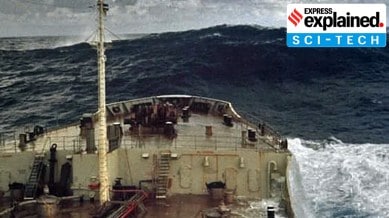What are ‘rogue waves’ and how can AI help predict them?
Rogue waves defy the average sea state, and are twice the size of surrounding waves, according to the US National Oceanic and Atmospheric Administration (NOAA).

Rogue waves — unusually large waves compared to ones which come before and after — pose a threat to ships, coastal and offshore infrastructure, and human lives. Unfortunately, there has existed no method to forecast rogue waves — until now.
Using billions of data points collected by a network of 172 ocean buoys, University of Maryland mathematicians Thomas Breunung and Balakumar Balachandran have trained an artificial intelligence programme to distinguish wave patterns that preceded rogue waves, up to five minutes in advance.
Deadly surprises
In oceanography, sea state refers to the condition of the surface of a large body of water at a certain location, at a certain point of time. The World Meteorological Organization (WMO) sea state code characterises sea state based on wave height on a scale of 0 (no waves) to 9 (waves over 14 m).
Rogue waves defy the average sea state, and are twice the size of surrounding waves, according to the US National Oceanic and Atmospheric Administration (NOAA). Such waves often form when swells — which occur not due to local winds, but distant weather systems — converge to raise a single, amplified wave. They may also form when ocean currents compress swells to create strong billows.
While scientists have long known rogue waves are not altogether unpredictable, the lack of a real-time forecasting method has had deadly consequences. According to oceanographer E G Didenkulova, between 2011 and 2018, rogue waves killed at least 386 people and sank 24 ships (“Catalogue of rogue waves occurred in the World Ocean from 2011 to 2018 reported by mass media sources”, 2020).
Promise of AI
Breunung and Balachandran considered 20-minute long samples recorded by ocean buoys. For samples containing rogue waves (as defined by NOAA), the recording ends at the point when the rogue waves occur. The rogue wave samples were then compared to all other samples (in which rogue waves did not occur) to train the AI programme.
This programme was subsequently able to predict about 75% rogue waves one minute in advance. Roughly 73% rogue waves could be predicted five minutes in advance. Crucially, the researchers demonstrated that the tool could be used to predict the emergence of rogue waves near two buoys at widely different depths not included within the data sets used for training the AI — suggesting that the tool may have universal predictive capabilities.
The study, “Prediction of freak waves from buoy measurements”, was published on July 18 in the journal Scientific Reports.